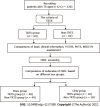Clinical characteristics of pediatric patients with treatment-refractory Tourette syndrome: An evidence-based survey in a Chinese population
- PMID: 36051602
- PMCID: PMC9331451
- DOI: 10.5498/wjp.v12.i7.958
Clinical characteristics of pediatric patients with treatment-refractory Tourette syndrome: An evidence-based survey in a Chinese population
Abstract
Background: Tourette syndrome (TS) is a complex neurodevelopmental condition marked by tics, as well as a variety of psychiatric comorbidities, such as obsessive-compulsive disorders (OCDs), attention deficit hyperactivity disorder (ADHD), anxiety, and self-injurious behavior. TS might progress to treatment-refractory Tourette syndrome (TRTS) in some patients. However, there is no confirmed evidence in pediatric patients with TRTS.
Aim: To investigate the clinical characteristics of TRTS in a Chinese pediatric sample.
Methods: A total of 126 pediatric patients aged 6-12 years with TS were identified, including 64 TRTS and 62 non-TRTS patients. The Yale Global Tic Severity Scale (YGTSS), Premonitory Urge for Tics Scale (PUTS), and Child Behavior Checklist (CBCL) were used to assess these two groups and compared the difference between the TRTS and non-TRTS patients.
Results: When compared with the non-TRTS group, we found that the age of onset for TRTS was younger (P < 0.001), and the duration of illness was longer (P < 0.001). TRTS was more often caused by psychosocial (P < 0.001) than physiological factors, and coprolalia and inappropriate parenting style were more often present in the TRTS group (P < 0.001). The TRTS group showed a higher level of premonitory urge (P < 0.001), a lower intelligence quotient (IQ) (P < 0.001), and a higher percentage of family history of TS. The TRTS patients demonstrated more problems (P < 0.01) in the "Uncommunicative", "Obsessive-Compulsive", "Social-Withdrawal", "Hyperactive", "Aggressive", and "Delinquent" subscales in the boys group, and "Social-Withdrawal" (P = 0.02) subscale in the girls group.
Conclusion: Pediatric TRTS might show an earlier age of onset age, longer duration of illness, lower IQ, higher premonitory urge, and higher comorbidities with ADHD-related symptoms and OCD-related symptoms. We need to pay more attention to the social communication deficits of TRTS.
Keywords: Child Behavior Checklist; Obsessive-compulsive disorder; Premonitory Urge for Tics Scale; Social withdrawal; Treatment-refractory Tourette syndrome; Yale Global Tic Severity Scale.
©The Author(s) 2022. Published by Baishideng Publishing Group Inc. All rights reserved.
Conflict of interest statement
Conflict-of-interest statement: All other authors report no conflict of interest for this article.
Figures



Similar articles
-
Clinical evaluation of premonitory urges in children and adolescents using the Chinese version of Individualized Premonitory Urge for Tics Scale.Front Psychiatry. 2023 Nov 16;14:1224825. doi: 10.3389/fpsyt.2023.1224825. eCollection 2023. Front Psychiatry. 2023. PMID: 38034925 Free PMC article.
-
Premonitory Urge for Tics Scale (PUTS): initial psychometric results and examination of the premonitory urge phenomenon in youths with Tic disorders.J Dev Behav Pediatr. 2005 Dec;26(6):397-403. doi: 10.1097/00004703-200512000-00001. J Dev Behav Pediatr. 2005. PMID: 16344654
-
The Behavioral and Emotional Profile of Pediatric Tourette Syndrome Based on CBCL in a Chinese Sample.Front Psychiatry. 2022 Feb 24;13:784753. doi: 10.3389/fpsyt.2022.784753. eCollection 2022. Front Psychiatry. 2022. PMID: 35280165 Free PMC article.
-
Tourette syndrome in a longitudinal perspective. Clinical course of tics and comorbidities, coexisting psychopathologies, phenotypes and predictors.Dan Med J. 2018 Apr;65(4):B5465. Dan Med J. 2018. PMID: 29619935 Review.
-
Challenges in the Diagnosis and Assessment in Patients with Tourette Syndrome and Comorbid Obsessive-Compulsive Disorder.Neuropsychiatr Dis Treat. 2021 Apr 30;17:1253-1266. doi: 10.2147/NDT.S251499. eCollection 2021. Neuropsychiatr Dis Treat. 2021. PMID: 33958867 Free PMC article. Review.
Cited by
-
Functional connectivity of the precuneus and posterior cingulate cortex moderates the relationship between tic symptoms and premonitory urge in tourette syndrome.Eur Child Adolesc Psychiatry. 2025 Mar 10. doi: 10.1007/s00787-025-02685-x. Online ahead of print. Eur Child Adolesc Psychiatry. 2025. PMID: 40063278
-
Clinical evaluation of premonitory urges in children and adolescents using the Chinese version of Individualized Premonitory Urge for Tics Scale.Front Psychiatry. 2023 Nov 16;14:1224825. doi: 10.3389/fpsyt.2023.1224825. eCollection 2023. Front Psychiatry. 2023. PMID: 38034925 Free PMC article.
-
Neuropsychiatric comorbidities and associated factors in 182 Chinese children with tic disorders.BMC Pediatr. 2024 Dec 7;24(1):803. doi: 10.1186/s12887-024-05306-9. BMC Pediatr. 2024. PMID: 39645567 Free PMC article.
-
Tourette syndrome research highlights from 2022.F1000Res. 2023 Oct 23;12:826. doi: 10.12688/f1000research.135702.2. eCollection 2023. F1000Res. 2023. PMID: 37691732 Free PMC article. Review.
-
Factors linked to prognosis in children with provisional tic disorder: a prospective cohort study.Eur J Pediatr. 2024 Sep;183(9):4009-4017. doi: 10.1007/s00431-024-05651-y. Epub 2024 Jul 1. Eur J Pediatr. 2024. PMID: 38951254
References
-
- Set KK, Warner JN. Tourette syndrome in children: An update. Curr Probl Pediatr Adolesc Health Care. 2021;51:101032. - PubMed
-
- Stafford M, Cavanna AE. Prevalence and clinical correlates of self-injurious behavior in Tourette syndrome. Neurosci Biobehav Rev. 2020;113:299–307. - PubMed
-
- Robertson MM. A personal 35 year perspective on Gilles de la Tourette syndrome: prevalence, phenomenology, comorbidities, and coexistent psychopathologies. Lancet Psychiatry. 2015;2:68–87. - PubMed
-
- Li F, Cui Y, Li Y, Guo L, Ke X, Liu J, Luo X, Zheng Y, Leckman JF. Prevalence of mental disorders in school children and adolescents in China: diagnostic data from detailed clinical assessments of 17,524 individuals. J Child Psychol Psychiatry. 2022;63:34–46. - PubMed
LinkOut - more resources
Full Text Sources

